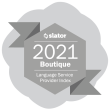What are the Main Steps in Preparing your Content for Localization
Author: Andreea Balaoiu
What are the Main Steps in Preparing your Content for Localization
Gone are the days when the challenge of tackling Translation and Localization was a “backbreaking” endeavor. Driven by global economic growth and technological developments, the process of preparing, translating, and localizing specific documentation has experienced a rapid evolution, with more and more Linguistic Service Providers stepping up their game to go above and beyond in delivering pristine Translation and Localization Services.
Localization Process Prerequisites
The preamble to any thorough Translation and Localization process is a well-planned and executed preparation process, ranging from content file prep to selecting and pursuing the best LSP (Linguistic Service Provider) fit for your localization profile. Thus, the structural source text evaluation, target audience analysis, and compliance, technical linguistic strategy compliance, as well as establishing a thorough prior Translation and Localization process workflow are of paramount importance in delivering quality-driven target content.

Content Localization: Process breakdown
An effective Content Localization process must be defined prior to beginning work on the translation. Compared to classic, ‘dictionary-in-hand’ grueling translation processes, proficient Language Service Providers will always ensure a streamlined translation and localization process, consisting of:
- Volume Analysis/timeframe estimations and technical file processing:
The source content is analyzed to determine the exact number of new and repeated words to be translated and the extent of TM (Translation Memory) leverage. (Learn more about the specifics of TM leverage in our article, What is Translation Memory - AD VERBUM)
The source content is then prepared for translation in a bilingual setting using a CAT (Computer Assisted Translation) tool and an existing/new Translation Memory.
- Carrying out the Translation, Editing, and Proofreading flow
The source content is translated into the target language, edited, and proofread, with each step performed by an independent native speaker and subject-matter expert of the target language using a CAT tool.
- Executing Quality Assurance
Quality assurance-specific tools and software are employed to check the translation for potential linguistic and stylistic errors. (Learn more about Linguistic Quality assurance in our article Quality Assurance in Translation Services - AD VERBUM). The target document is reviewed to make sure that the layout is the same as in the source document, involving a DTP (Desktop Publishing) step if required by the client and file format.
And finally, client feedback is implemented into the final TM (Translation Memory) and client-specific glossary and/or style guide, where applicable, marking the end step into a streamlined process of file preparation and compilation before delivery to the end client.

Main Steps and Benefits of Content preparation for Translation and Localization Services
In the article “How to Prepare a Localization Kit”, Sedef Olcer outlines the importance of establishing a detailed “Localization kit” and thoroughly preparing files before commencing the localization process.
The first element to consider within the User Interface (GUI), is the incoming files, as most often than not when dealing with client-Localization Vendor relationships, the back and forth send-out of a multitude of files can result in elements being lost, misplaced, or corrupted.
Other components deal with translatable versus untranslatable files, which can be streamlined and managed by compiling the Localization exclusive files in a pre-defined folder structure. Of course, it goes without saying that the clients’ file (preferably in binary file extensions: (.EXE, .DLL, VBX files) extensions must be adhered to, as Localization vendors’ applications will process and engineer them in real-time.
Additionally, compiling the client’s style guide, Translation Memories, Glossary, or another relevant vocabulary database will be of utmost importance for the file preparation and adherence to client requirements.
Lastly in the case of localizing graphics, which mostly consist of text overlayed on structured backgrounds, linguistic vendors or LSPs (Language Service Providers) will need to prepare and access the documents in “text-only” format, as in the case of GIF or JPEG simple files, the text is embedded on the background layer.
The Bottom Line
Achieving accurate and competent content Localization, as well as ensuring streamlined translation quality assurance is mandatory for scaling any business. The ever-growing interest in safeguarding the level and values of quality is gaining momentum, with the generic approaches to translation and localization quality demanding superior benchmarks, as well as thorough content preparation, aligned to specific requirements and conditions of the end client.
AD VERBUM takes pride in mastering and delivering on the specifics of Translation and Localization, ticking all of the above-mentioned criteria boxes through a well-established internal File preparation workflow and Translation Quality Assurance process, ISO-optimized to cater to a wide spectrum of needs and stringent requirements.
By tailoring our efforts to the specific needs of every single customer and following up on our performance, we ensure that the technical translation services provided are of consistently high quality and thus this enhances the experience for all our customers.











